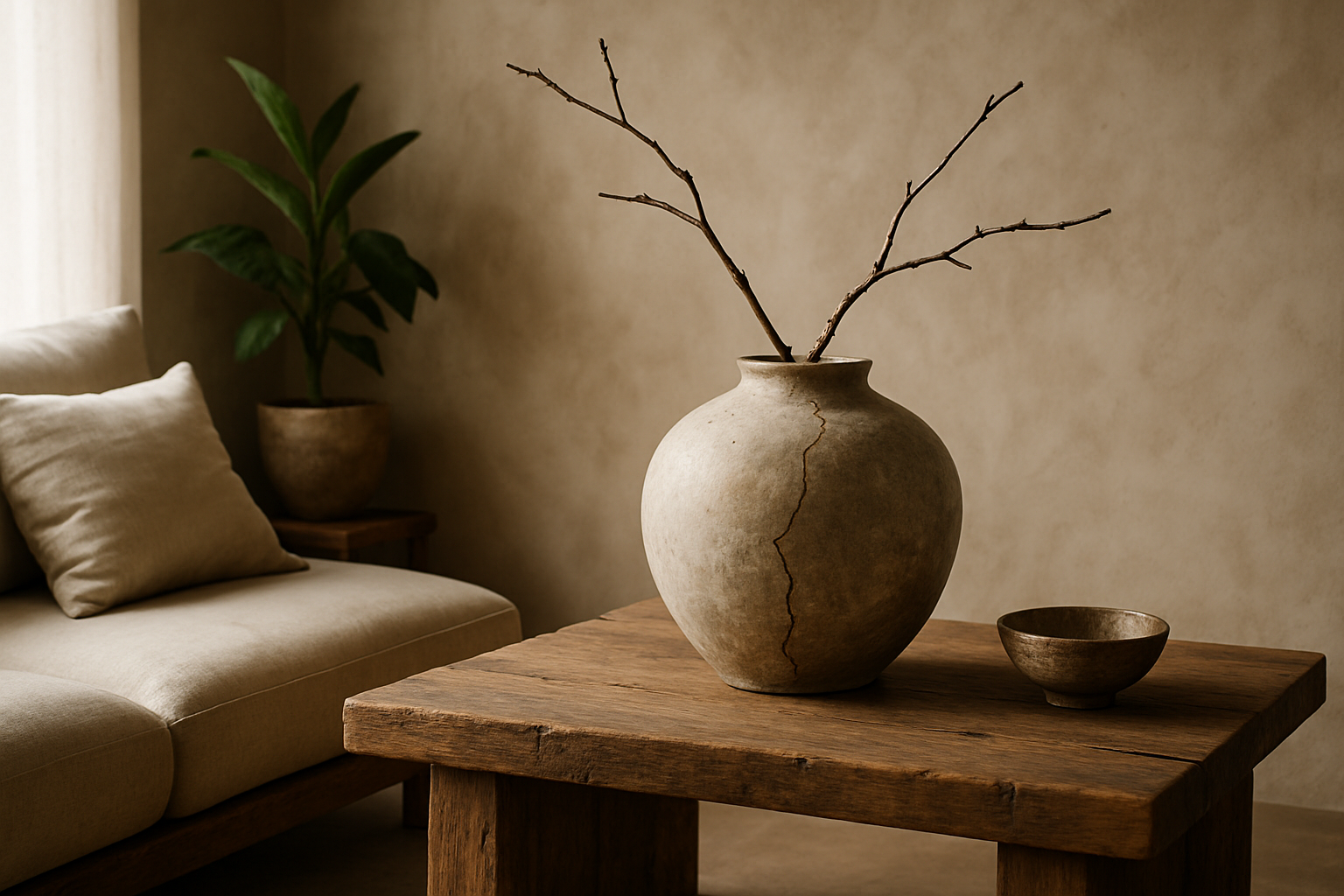Embracing Wabi-Sabi: The Art of Imperfect Beauty in Home Design
The pursuit of perfection in home decor often leads to sterile, impersonal spaces. But what if we told you that embracing imperfection could create a more authentic, soulful living environment? Enter wabi-sabi, a Japanese philosophy that celebrates the beauty of imperfection, transience, and incompleteness. This ancient concept is making waves in modern home design, offering a refreshing counterpoint to the polished aesthetics that dominate social media feeds.

The Origins of Wabi-Sabi
Wabi-sabi has its roots in 16th century Japanese tea ceremonies, where simplicity and rustic elegance were prized over ornate perfection. The term combines two concepts: wabi, which refers to the beauty of simplicity and humility, and sabi, which embraces the passage of time and the beauty of age.
Originally, wabi-sabi was closely tied to Zen Buddhism, reflecting the impermanence of all things and the acceptance of natural cycles of growth and decay. In the context of home design, it translates to an appreciation for natural materials, handcrafted objects, and spaces that evolve and age gracefully over time.
The Aesthetics of Imperfection
At its core, wabi-sabi design embraces asymmetry, roughness, and simplicity. It favors natural materials like wood, stone, and clay, often left in their raw, unfinished state. Textures are rich and varied, from the rough grain of unpolished wood to the subtle irregularities of hand-thrown pottery.
Colors in wabi-sabi interiors tend to be muted and earthy, drawing inspiration from nature. Think soft greys, warm browns, and gentle greens. These subdued hues create a calm, grounding atmosphere that allows the inherent beauty of materials and objects to shine through.
Incorporating Wabi-Sabi into Your Home
Embracing wabi-sabi doesn’t mean letting your home fall into disrepair. Instead, it’s about curating a space that feels authentic and lived-in. Start by decluttering and simplifying your space, keeping only items that are functional or bring genuine joy.
Introduce natural elements like plants, driftwood, or river stones. Opt for furniture and decor with organic shapes and imperfect finishes. Handmade ceramics, textiles with visible weaves, and furniture with knots or grain patterns all embody the wabi-sabi spirit.
Don’t be afraid of wear and tear. A weathered wooden table, a slightly chipped vase, or a frayed edge on a rug can add character and depth to your space. These imperfections tell a story and give your home a sense of history and personality.
The Psychological Benefits of Wabi-Sabi
Beyond aesthetics, wabi-sabi offers profound psychological benefits. In a culture that often equates perfection with success, embracing imperfection can be deeply liberating. Wabi-sabi interiors encourage mindfulness and presence, inviting us to slow down and appreciate the subtle beauty around us.
Research suggests that environments that reflect wabi-sabi principles can reduce stress and promote feelings of calm and contentment. By surrounding ourselves with natural materials and imperfect objects, we create a more forgiving, less demanding living space. This can lead to increased self-acceptance and a healthier relationship with our homes and possessions.
Wabi-Sabi in the Digital Age
In an era of Instagram-perfect interiors, wabi-sabi offers a refreshing alternative. It encourages us to create spaces that are authentic and personal, rather than striving for an unattainable ideal of perfection. This doesn’t mean rejecting modern conveniences or technology, but rather integrating them thoughtfully into a more organic, lived-in environment.
Many homeowners are finding creative ways to blend wabi-sabi principles with contemporary design. For example, combining sleek, modern furniture with raw, natural materials, or using digital photo frames to display imperfect, candid moments rather than polished portraits.
The Future of Wabi-Sabi in Home Design
As we move towards more sustainable and mindful ways of living, wabi-sabi is likely to gain even more traction in the world of home design. Its emphasis on natural materials, longevity, and appreciation for imperfection aligns well with growing concerns about overconsumption and environmental impact.
Designers are increasingly incorporating wabi-sabi elements into their work, creating spaces that feel both contemporary and timeless. We’re seeing a rise in the use of reclaimed materials, artisanal crafts, and designs that celebrate the natural aging process of materials.
Wabi-Sabi and Sustainability
The wabi-sabi philosophy naturally lends itself to sustainable living practices. By valuing items that age gracefully and improve with use, we’re encouraged to buy less and cherish what we have for longer. This approach counters the throwaway culture that has dominated in recent decades.
Wabi-sabi interiors often feature repurposed or upcycled items, giving new life to old materials. For example, a weathered barn door might become a striking dining table, or vintage glass bottles could be repurposed as unique vases. This not only reduces waste but also adds character and story to our living spaces.
Balancing Wabi-Sabi with Modern Life
While the principles of wabi-sabi are rooted in ancient philosophy, they can be seamlessly integrated into modern lifestyles. The key is to find a balance that works for you. Not everyone will want to fully embrace a rustic, imperfect aesthetic, but elements of wabi-sabi can be incorporated into any design style.
For instance, in a minimalist modern interior, a single piece of weathered driftwood or a handmade ceramic bowl can add warmth and character. In a more traditional space, choosing natural fabrics with visible textures or allowing wooden furniture to develop a patina over time can bring in the wabi-sabi spirit.
Cultivating a Wabi-Sabi Mindset
Embracing wabi-sabi in home design is as much about mindset as it is about aesthetics. It invites us to shift our perspective, finding beauty in the overlooked and value in the imperfect. This approach can extend beyond our homes, influencing how we approach life, relationships, and personal growth.
By cultivating a wabi-sabi mindset, we learn to appreciate the present moment, accept the natural cycles of life, and find contentment in simplicity. In our homes, this translates to spaces that feel authentic, peaceful, and deeply connected to the natural world.
As we navigate an increasingly complex and fast-paced world, the principles of wabi-sabi offer a timely reminder to slow down, embrace imperfection, and find beauty in the simple, the weathered, and the imperfect. In doing so, we create homes that are not just visually appealing, but deeply nourishing to the soul.





